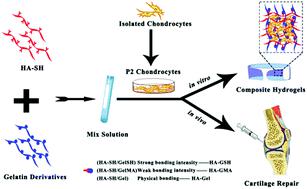当前位置:
X-MOL 学术
›
J. Mater. Chem. B
›
论文详情
Our official English website, www.x-mol.net, welcomes your feedback! (Note: you will need to create a separate account there.)
Effects of the bonding intensity between hyaluronan and gelatin on chondrogenic phenotypic maintenance.
Journal of Materials Chemistry B ( IF 7 ) Pub Date : 2020-08-25 , DOI: 10.1039/d0tb01816c Yuxiang Wang 1 , Yafang Chen 1 , Yang Xu 1 , Manyu Chen 1 , Yan Lu 1 , Jie Liang 1 , Yong Sun 1 , Yujiang Fan 1 , Xingdong Zhang 1
Journal of Materials Chemistry B ( IF 7 ) Pub Date : 2020-08-25 , DOI: 10.1039/d0tb01816c Yuxiang Wang 1 , Yafang Chen 1 , Yang Xu 1 , Manyu Chen 1 , Yan Lu 1 , Jie Liang 1 , Yong Sun 1 , Yujiang Fan 1 , Xingdong Zhang 1
Affiliation

|
Although there have been many reports on the use of crosslinked hyaluronic acid and gelatin derivatives as injectable hydrogels in cartilage tissue engineering, however, almost no reports have analyzed the kinds of bonding intensity that were most conducive for the maintenance of cartilage phenotypes. Herein, the biomimetic composite hydrogels based on thiolated hyaluronic acid and modified gelatin derivatives with physical mixed, weak, and strong bonding intensity were fabricated, wherein the thiolated hyaluronic acid ensured the basic network structure of composite hydrogels, and gelatin derivatives endowed the bioactivity to hydrogels. These physicochemical properties of composite hydrogels implied that strong bonding intensity (HA–GSH) contributed to the maintenance of a more uniform pore structure, and increased the ability of water retention and resistance to degradation. Further immunohistochemical and RT-PCR analyses demonstrated that the HA–GSH hydrogel greatly improved the expression level of the associated cartilage matrix and the possibility of hyaline cartilage formation in comparison to the physically blended HA–Gel gel and weak bonding crosslinked HA–GMA gel. Overall, all results proved that strong bonding intensity of the disulfide bonds in the HA–GSH hydrogel was more beneficial for the proliferation of chondrocytes and the maintenance of the hyaline cartilage phenotype, which might provide valuable inspiration for designing cartilage repair scaffolds.
中文翻译:

透明质酸和明胶之间的结合强度对软骨形成表型维持的影响。
尽管有许多关于在软骨组织工程中使用交联透明质酸和明胶衍生物作为可注射水凝胶的报道,但是,几乎没有报道分析过最有利于维持软骨表型的键合强度。本文制备了一种以巯基化透明质酸和改性明胶衍生物为基础的物理混合,弱,强结合强度的仿生复合水凝胶,其中硫醇化透明质酸确保了复合水凝胶的基本网络结构,明胶衍生物赋予了水凝胶生物活性。复合水凝胶的这些理化性质表明强结合强度(HA–GSH)有助于维持更均匀的孔结构,并提高了保水能力和抗降解能力。进一步的免疫组织化学和RT-PCR分析表明,与物理混合的HA-Gel凝胶和弱结合的交联HA-GMA凝胶相比,HA-GSH水凝胶大大改善了相关软骨基质的表达水平,并提高了透明软骨形成的可能性。总的来说,所有结果证明,HA-GSH水凝胶中二硫键的强结合强度更有利于软骨细胞的增殖和维持透明软骨表型,这可能为设计软骨修复支架提供宝贵的启示。进一步的免疫组织化学和RT-PCR分析表明,与物理混合的HA-Gel凝胶和弱结合的交联HA-GMA凝胶相比,HA-GSH水凝胶大大改善了相关软骨基质的表达水平,并提高了透明软骨形成的可能性。总的来说,所有结果证明,HA-GSH水凝胶中二硫键的强结合强度更有利于软骨细胞的增殖和维持透明软骨表型,这可能为设计软骨修复支架提供宝贵的启示。进一步的免疫组织化学和RT-PCR分析表明,与物理混合的HA-Gel凝胶和弱结合的交联HA-GMA凝胶相比,HA-GSH水凝胶大大改善了相关软骨基质的表达水平,并提高了透明软骨形成的可能性。总的来说,所有结果证明,HA-GSH水凝胶中二硫键的强结合强度更有利于软骨细胞的增殖和维持透明软骨表型,这可能为设计软骨修复支架提供宝贵的启示。
更新日期:2020-10-14
中文翻译:

透明质酸和明胶之间的结合强度对软骨形成表型维持的影响。
尽管有许多关于在软骨组织工程中使用交联透明质酸和明胶衍生物作为可注射水凝胶的报道,但是,几乎没有报道分析过最有利于维持软骨表型的键合强度。本文制备了一种以巯基化透明质酸和改性明胶衍生物为基础的物理混合,弱,强结合强度的仿生复合水凝胶,其中硫醇化透明质酸确保了复合水凝胶的基本网络结构,明胶衍生物赋予了水凝胶生物活性。复合水凝胶的这些理化性质表明强结合强度(HA–GSH)有助于维持更均匀的孔结构,并提高了保水能力和抗降解能力。进一步的免疫组织化学和RT-PCR分析表明,与物理混合的HA-Gel凝胶和弱结合的交联HA-GMA凝胶相比,HA-GSH水凝胶大大改善了相关软骨基质的表达水平,并提高了透明软骨形成的可能性。总的来说,所有结果证明,HA-GSH水凝胶中二硫键的强结合强度更有利于软骨细胞的增殖和维持透明软骨表型,这可能为设计软骨修复支架提供宝贵的启示。进一步的免疫组织化学和RT-PCR分析表明,与物理混合的HA-Gel凝胶和弱结合的交联HA-GMA凝胶相比,HA-GSH水凝胶大大改善了相关软骨基质的表达水平,并提高了透明软骨形成的可能性。总的来说,所有结果证明,HA-GSH水凝胶中二硫键的强结合强度更有利于软骨细胞的增殖和维持透明软骨表型,这可能为设计软骨修复支架提供宝贵的启示。进一步的免疫组织化学和RT-PCR分析表明,与物理混合的HA-Gel凝胶和弱结合的交联HA-GMA凝胶相比,HA-GSH水凝胶大大改善了相关软骨基质的表达水平,并提高了透明软骨形成的可能性。总的来说,所有结果证明,HA-GSH水凝胶中二硫键的强结合强度更有利于软骨细胞的增殖和维持透明软骨表型,这可能为设计软骨修复支架提供宝贵的启示。



























 京公网安备 11010802027423号
京公网安备 11010802027423号